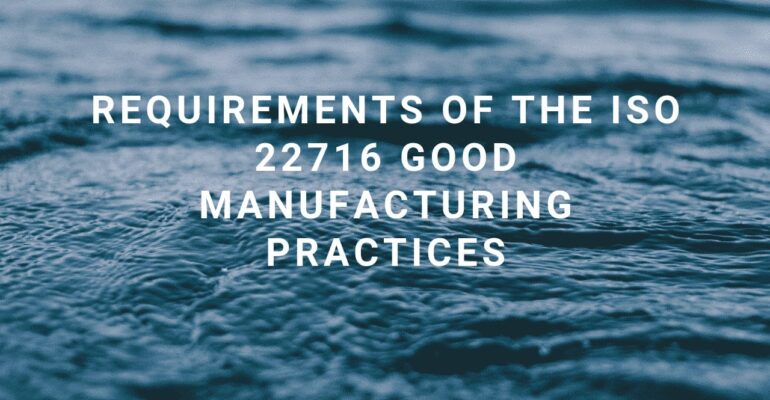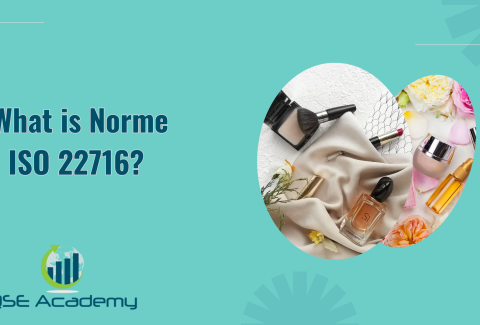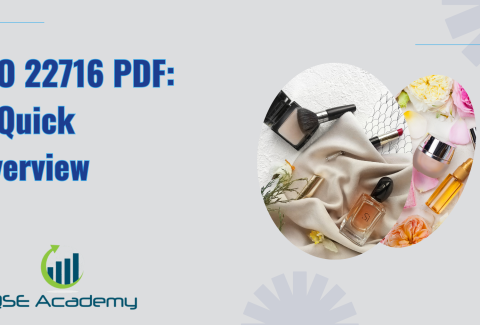Requirements of the ISO 22716 Good Manufacturing Practices
Requirements of the ISO 22716 Good Manufacturing Practices
If you’ve ever wondered how cosmetics manufacturers ensure their products are consistently safe and high-quality, the answer lies in ISO 22716 requirements. These globally recognized standards serve as a practical framework for implementing Good Manufacturing Practices (GMP) specifically tailored to the cosmetics industry.
Let’s break it down: ISO 22716 requirements cover everything from the people involved in production to the equipment, materials, and processes used to make cosmetics. The goal is to ensure that every step of the manufacturing process is well-organized, controlled, and traceable.
Why Are ISO 22716 Requirements Important?
Imagine buying a moisturizer or lipstick without knowing whether it was made in a clean, controlled environment. Not very reassuring, right? That’s where ISO 22716 comes in. By following its guidelines, manufacturers can:
- Minimize contamination risks.
- Maintain consistent product quality across batches.
- Build trust with consumers and regulators alike.
These requirements are especially critical for companies aiming to sell in markets like the EU, where compliance with ISO 22716 requirements is often tied to meeting regulatory standards, such as the European Cosmetics Regulation (EC No. 1223/2009).
What Do ISO 22716 Requirements Cover?
Here’s a quick overview of the main areas these standards address:
- Personnel and Training: Ensuring staff are well-trained and maintain proper hygiene.
- Premises and Equipment: Keeping facilities clean and equipment properly maintained to prevent contamination.
- Raw Materials and Packaging: Establishing clear protocols for sourcing, storing, and handling ingredients and packaging materials.
- Production and Process Control: Standardizing workflows to ensure consistent, high-quality products.
- Documentation and Traceability: Maintaining detailed records so every step of the process can be traced and verified.
By addressing these areas, ISO 22716 requirements create a solid foundation for reliable, high-quality cosmetics production.
In short, ISO 22716 requirements are the gold standard for ensuring safety and quality in cosmetics manufacturing. They provide clear, actionable guidelines that help businesses meet both industry expectations and regulatory demands while earning the trust of their customers. Whether you’re a startup or a global brand, adopting ISO 22716 is a smart move for long-term success!
Key Elements of ISO 22716 Requirements
When it comes to cosmetics manufacturing, ISO 22716 requirements provide a roadmap to ensure that everything runs smoothly, safely, and consistently. These elements are the backbone of Good Manufacturing Practices (GMP) and focus on every aspect of the production process, from staff training to quality control. Let’s explore these essential components and how they help create safe, high-quality cosmetics.
1. Personnel and Training
One of the first things ISO 22716 emphasizes is the importance of well-trained personnel. After all, your team is at the heart of every product you create.
ISO 22716 requirements ensure that:
- Employees understand and follow hygiene practices to avoid contamination.
- Staff know their roles and responsibilities in maintaining product quality.
- Regular training sessions keep everyone up-to-date on new standards or procedures.
Think of it this way: A knowledgeable, skilled team is your first line of defense against errors or inconsistencies.
2. Premises and Equipment
Ever heard the saying, “A clean workspace is a productive workspace”? That’s especially true in cosmetics manufacturing. ISO 22716 requirements place a big focus on maintaining clean and well-organized facilities.
Here’s what it involves:
- Premises: Facilities should be designed to prevent cross-contamination, with dedicated areas for raw materials, production, and finished goods.
- Equipment: Machines need to be regularly cleaned, maintained, and calibrated to ensure they’re working perfectly.
For example, a well-maintained mixer ensures that your lotion has the same silky texture every single time.
3. Raw Materials and Packaging
The quality of your final product depends heavily on the materials you use. That’s why ISO 22716 requirements include strict guidelines for handling raw materials and packaging.
These include:
- Inspecting and testing raw materials to ensure they meet quality standards.
- Storing ingredients in appropriate conditions (e.g., temperature-controlled rooms).
- Using packaging that protects the product’s integrity and prevents contamination.
By carefully managing materials, you’re ensuring that every product is safe and consistent from the inside out.
4. Production and Process Control
Consistency is key in cosmetics manufacturing. Nobody wants a shampoo that’s perfect one day and watery the next. ISO 22716 requirements ensure that production processes are standardized and closely monitored.
This involves:
- Following Standard Operating Procedures (SOPs) for every step of production.
- Conducting in-process checks to catch any issues before they become bigger problems.
- Using batch records to document how each product is made.
With these controls in place, your customers can trust that their favorite products will always deliver the same results.
5. Documentation and Record-Keeping
If it’s not documented, it didn’t happen. That’s a mantra of ISO 22716 requirements, and for good reason. Accurate records are essential for traceability, quality control, and compliance.
Key documentation includes:
- Batch production records that detail every step of the process.
- Cleaning logs to show that equipment is properly sanitized.
- Supplier records to ensure raw materials meet quality standards.
Not only does this help you maintain consistency, but it also makes it easier to trace and fix issues if something goes wrong.
Why These Elements Matter
The beauty of ISO 22716 requirements is how they bring all these elements together into one cohesive system. By focusing on personnel, facilities, materials, processes, and documentation, you’re building a foundation for safe, high-quality production.
These practices don’t just protect your customers—they also protect your brand by reducing risks and ensuring compliance with global regulations. And that’s a win-win for everyone involved!
Benefits of Adhering to ISO 22716 Requirements
Following ISO 22716 requirements might seem like a big commitment at first, but the benefits make it well worth the effort. These guidelines don’t just help you stay compliant—they elevate your entire business. From building consumer trust to streamlining operations, here’s how meeting ISO 22716 standards can transform your cosmetics manufacturing process.
1. Ensuring Product Safety
Safety is a top priority in cosmetics manufacturing, and ISO 22716 requirements are designed to minimize risks. By following these guidelines, you can:
- Prevent contamination during production.
- Ensure that raw materials and packaging meet strict quality standards.
- Identify and address potential safety issues before products reach the market.
For example, maintaining clean facilities and properly training your staff reduces the risk of introducing harmful contaminants into your products. The result? Safer cosmetics that customers can trust.
2. Building Consumer Trust
In the cosmetics industry, trust is everything. When customers know that your brand adheres to ISO 22716 requirements, they feel confident in the safety and quality of your products.
This trust translates into:
- Loyal customers who return to your brand time and time again.
- Positive reviews and recommendations that help grow your reputation.
- A competitive edge in a crowded market where consumers value transparency and accountability.
By showing your commitment to Good Manufacturing Practices (GMP), you’re sending a clear message: “We care about your safety.”
3. Streamlining Operations
One of the lesser-known benefits of ISO 22716 requirements is how they help improve efficiency. These guidelines encourage you to standardize your processes, maintain clear documentation, and regularly review your operations.
This leads to:
- Fewer production errors and less waste.
- Easier training for new employees, thanks to standardized procedures.
- Faster problem-solving when issues arise, thanks to detailed records and traceability.
In short, following ISO 22716 isn’t just about compliance—it’s about making your business run more smoothly.
4. Meeting Global Regulatory Standards
Compliance with ISO 22716 requirements is recognized worldwide, making it an essential step for businesses looking to expand into international markets. In regions like the European Union, adherence to ISO 22716 is often mandatory under local regulations.
By meeting these standards, you can:
- Avoid costly fines or penalties for non-compliance.
- Simplify the process of entering new markets.
- Build credibility with retailers and distributors who prioritize safety and quality.
For manufacturers with global ambitions, ISO 22716 is a must.
5. Reducing Risk and Liability
Nobody wants to deal with product recalls, legal disputes, or reputational damage. By following ISO 22716 requirements, you’re taking proactive steps to reduce these risks.
Key benefits include:
- Clear documentation that makes it easier to identify and fix issues quickly.
- A structured approach to quality control that minimizes the chance of errors.
- Increased accountability at every stage of production.
This risk reduction isn’t just good for your business—it’s also a relief for your customers, who can feel confident in the safety of your products.
Why These Benefits Matter
Meeting ISO 22716 requirements isn’t just about checking boxes—it’s about building a stronger, more reliable business. These guidelines help you create cosmetics that are safe, consistent, and trusted by customers and regulators alike.
By embracing these standards, you’re not just staying compliant—you’re setting your brand apart as a leader in quality and care. And in the competitive world of cosmetics, that makes all the difference!
Common Challenges in Meeting ISO 22716 Requirements
While adopting ISO 22716 requirements can bring immense benefits, the journey isn’t always smooth. For many cosmetics manufacturers, implementing these guidelines can feel overwhelming at first. The good news? Understanding the challenges ahead can help you navigate them with confidence. Let’s explore some of the most common hurdles and how to tackle them effectively.
1. Managing Extensive Documentation
One of the key components of ISO 22716 requirements is maintaining detailed records for every step of your manufacturing process. From batch production logs to cleaning schedules, the paperwork can quickly pile up.
Why it’s a challenge:
- Documentation needs to be accurate, consistent, and accessible.
- Small errors or missing records can lead to compliance issues.
How to overcome it:
- Use digital tools to streamline record-keeping. Compliance management software can automate tasks like batch tracking and equipment logs.
- Create clear templates for common documents to save time and maintain consistency.
- Train your team on the importance of documentation and how to do it correctly.
2. Upgrading Facilities and Equipment
ISO 22716 places a strong emphasis on maintaining clean, well-organized facilities and properly functioning equipment. For some businesses, meeting these standards might require significant upgrades.
Why it’s a challenge:
- Facility redesigns or equipment replacements can be costly and time-consuming.
- Ensuring that all areas meet hygiene standards requires ongoing effort.
How to overcome it:
- Start with a gap analysis to identify areas that need improvement.
- Prioritize upgrades based on their impact on compliance and safety.
- Spread out investments over time to manage costs more effectively.
3. Training and Engaging Staff
Your team plays a vital role in meeting ISO 22716 requirements, but getting everyone on board can be tricky. Employees might feel overwhelmed by new protocols or resistant to change.
Why it’s a challenge:
- Training requires time and resources, especially for larger teams.
- Consistency can be difficult if employees don’t fully understand their roles in compliance.
How to overcome it:
- Provide hands-on training that explains not just the “how” but also the “why” of ISO 22716 requirements.
- Offer regular refresher courses to keep everyone up-to-date.
- Encourage a culture of quality where employees feel valued for their contributions to compliance.
4. Ensuring Consistency Across Processes
Consistency is at the heart of ISO 22716 requirements, but maintaining it can be a challenge, especially as your operations scale.
Why it’s a challenge:
- Variations in production processes can lead to inconsistencies in product quality.
- Small lapses in hygiene or quality control can escalate into bigger issues.
How to overcome it:
- Develop clear Standard Operating Procedures (SOPs) for every task.
- Conduct regular internal audits to catch and fix inconsistencies early.
- Use Key Performance Indicators (KPIs) to track and measure compliance.
5. Adapting to Regulatory Updates
Regulations don’t stay the same forever, and staying compliant with ISO 22716 requirements means keeping up with any changes in global or regional standards.
Why it’s a challenge:
- It can be hard to stay on top of updates, especially if you’re already juggling daily operations.
- Adapting processes to meet new standards may require additional time and resources.
How to overcome it:
- Subscribe to industry newsletters and updates from regulatory bodies.
- Attend workshops or training sessions to stay informed about changes.
- Consider hiring a compliance consultant who can provide expert guidance.
6. Financial Investment
From facility upgrades to training programs, implementing ISO 22716 requirements involves upfront costs. For smaller businesses, these expenses can feel like a major barrier.
Why it’s a challenge:
- Budgets might not accommodate immediate upgrades or external support.
- It can be hard to see the long-term benefits when focusing on short-term costs.
How to overcome it:
- View compliance as an investment in your brand’s reputation and future growth.
- Apply for grants or funding opportunities that support quality and safety initiatives.
- Start small and gradually scale your efforts as resources allow.
Why These Challenges Are Worth Overcoming
While the path to meeting ISO 22716 requirements may not be easy, it’s absolutely worth the effort. These challenges push you to create safer, higher-quality products and build a stronger, more reliable business.
With a proactive approach and the right tools, you can tackle these obstacles one step at a time. And remember—every improvement you make brings you closer to achieving compliance and earning the trust of your customers. You’ve got this!
Tips for Successfully Implementing ISO 22716 Requirements
Implementing ISO 22716 requirements might feel like a big undertaking, but with the right strategies, it’s absolutely achievable. Whether you’re starting from scratch or refining your existing practices, these tips can help you navigate the process smoothly and confidently.
1. Begin with a Gap Analysis
Before you dive in, it’s essential to figure out where you stand. A gap analysis helps you compare your current operations to the requirements of ISO 22716 and identify areas that need improvement.
Here’s how to do it:
- Review your facilities, processes, and documentation.
- Highlight any gaps between your current practices and ISO 22716 requirements.
- Prioritize the areas that need immediate attention, like hygiene standards or staff training.
This step gives you a clear roadmap, so you’re not wasting time or resources on guesswork.
2. Train Your Team
Your employees are the backbone of your business, and they play a critical role in meeting ISO 22716 requirements. Without proper training, even the best systems can fail.
What to focus on in training:
- Teach employees about hygiene practices to prevent contamination.
- Ensure everyone understands their responsibilities in following GMP.
- Provide practical, hands-on training for tasks like documenting processes or maintaining equipment.
Regular refresher courses can also help keep everyone up-to-date with any changes in your procedures.
3. Standardize Your Processes
Consistency is key to meeting ISO 22716 requirements, and standardizing your operations is the best way to achieve it. This means creating clear, step-by-step guidelines for every task.
What to include in your Standard Operating Procedures (SOPs):
- Cleaning and sanitizing equipment.
- Handling and storing raw materials.
- Conducting quality checks during production.
Having SOPs not only ensures consistency but also makes training new employees much easier.
4. Leverage Technology
Managing the documentation and processes required by ISO 22716 requirements can be overwhelming, but technology can make it much more manageable.
How technology can help:
- Use compliance software to track documentation, audits, and records.
- Automate routine tasks like cleaning schedules or equipment maintenance reminders.
- Centralize your data so it’s easy to access during inspections or audits.
By investing in digital tools, you’ll save time and reduce the risk of human error.
5. Conduct Regular Internal Audits
Internal audits are your best defense against compliance issues. By regularly reviewing your operations, you can catch and fix problems before they escalate.
How to run effective audits:
- Check your facilities for cleanliness and proper organization.
- Review your documentation to ensure accuracy and completeness.
- Verify that employees are following your SOPs and GMP guidelines.
Make audits a routine part of your operations—it’s much easier to stay compliant when you’re always prepared.
6. Focus on Continuous Improvement
Compliance with ISO 22716 requirements isn’t a one-and-done deal. It’s an ongoing process of refining your operations and finding new ways to improve.
Ways to embrace continuous improvement:
- Collect feedback from your team and customers to identify pain points.
- Monitor your Key Performance Indicators (KPIs) to track progress.
- Stay informed about updates to ISO 22716 and global cosmetic regulations.
By fostering a culture of improvement, you’re setting your business up for long-term success.
7. Don’t Be Afraid to Seek Help
If the process feels overwhelming, you don’t have to go it alone. Consultants or experts in ISO 22716 requirements can provide invaluable guidance.
Benefits of working with an expert:
- They can help you interpret complex requirements and apply them to your operations.
- They can assist with training your team or conducting audits.
- They provide peace of mind, knowing your compliance efforts are on track.
Why These Tips Matter
Successfully implementing ISO 22716 requirements is about more than just meeting regulations—it’s about building a stronger, more efficient business. By taking a step-by-step approach and using the right tools, you’ll not only achieve compliance but also create safer, higher-quality products that your customers can trust.
Remember, every small improvement adds up to a big difference. With patience, consistency, and a proactive mindset, you’ll have everything you need to make ISO 22716 work for you!
Your Next Step
If you’re ready to take your cosmetics manufacturing to the next level, start by understanding where you are now. Conduct a gap analysis, train your team, and use tools to simplify the process. Remember, compliance isn’t an overnight journey, but with patience and consistency, you’ll get there.
Meeting ISO 22716 requirements isn’t just about ticking boxes—it’s about creating products that you, your customers, and your team can be proud of. And that’s something worth striving for!
Let’s make ISO less about stress and more about success! 🙏
make ISO standards less intimidating and more approachable for everyone.
Whether it’s ISO 9001, ISO 22000, or the cosmetics-focused ISO 22716,
I’ve spent my career turning complex jargon into clear, actionable steps
that businesses can actually use. I’m not here to call myself an expert—I prefer “enthusiast” because I truly love what I do.
There’s something incredibly rewarding about helping people navigate food safety and quality management systems
in a way that feels simple, practical, and even enjoyable.
When I’m not writing about standards, you’ll probably find me playing Piano 🎹, connecting with people, or diving into my next big project💫.
Looking for More Resources on ISO 22716?
If you found this article helpful, explore our premium resources designed to help you achieve ISO 22716 certification efficiently:
- 📦 Complete Documentation Package for ISO/IEC 22716 2017: Get all the essential templates and documents you need for fast, easy implementation.
- 🎓 Online Course on ISO/IEC 22716 2017 : Enroll in our comprehensive training to master the key concepts and practical steps toward certification.
- 📋 ISO/IEC 22716 2017 Checklist: Download our detailed checklist to ensure you’ve covered every step of the process.
These resources are tailored to meet your needs and ensure a smooth certification journey. Explore them today and get one step closer to success!





















